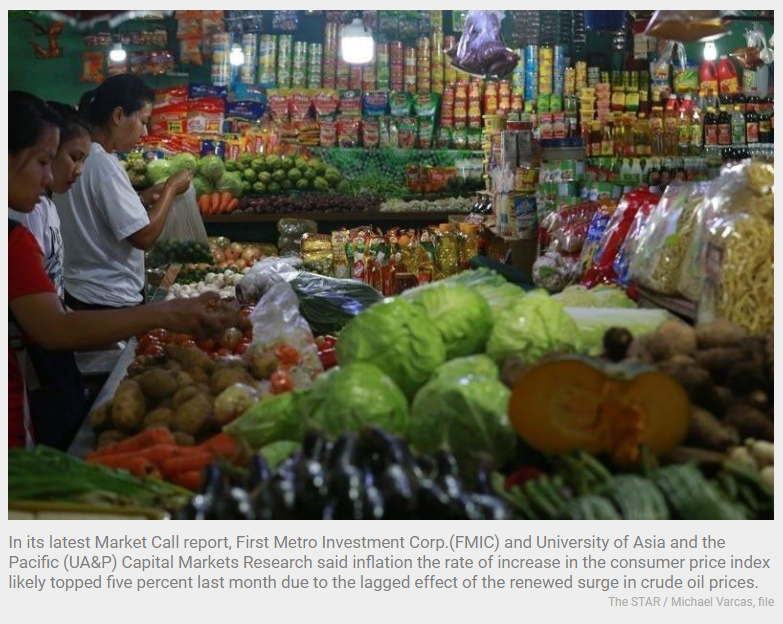Philippines: Inflation seen to top 5% in October
MANILA, Philippines — Prices of basic goods and services likely accelerated in October as global crude costs remain at three-year highs, but would start easing next year due to a lower base and the absence of one-off price increases.
In its latest Market Call report, First Metro Investment Corp.(FMIC) and University of Asia and the Pacific (UA&P) Capital Markets Research said inflation the rate of increase in the consumer price index likely topped five percent last month due to the lagged effect of the renewed surge in crude oil prices.
For October, the Bangko Sentral ng Pilipinas (BSP) expects inflation to settle between 4.5 and 5.3 percent on higher electricity rates as well as oil and food prices.
Inflation unexpectedly slowed to 4.8 percent in September but economists said this was likely a blip and would not be sustained in the coming months.
Average inflation for the year now stands at 4.5 percent, breaching the central bank’s 4.4 percent target for 2021.
But even with the expected uptick, FMIC and UA&P maintained that inflation would start cooling below four percent by December.
“We still think headline inflation will fall below four percent by December and remain there in 2022, since we saw huge upticks in November and December 2020,” they said.
Global debt watcher Moody’s Investor Service, meanwhile, pointed out that inflation would subside in 2022 in most economies as base effects reverse and the effects of one-off price increases fade.
“But inflation risks remain high. Elevated inflation will strain household budgets and weigh on growth, especially if job market conditions remain weak. It also has the potential to trigger food price controls and mandated wage hikes in emerging markets, which could weaken corporate profitability in affected sectors in those countries,” said Elena Duggar, managing director at Moody’s.
She said supply chain disruptions, labor shortages and higher prices for some goods and services resulting from pandemic-induced lockdowns and fitful reopenings would stretch into 2022, but effects would lessen in the second half of the year.
“But there is considerable uncertainty around our forecasts and a risk that inflation will remain higher for longer than expected, particularly in the US and in some emerging market countries,” she said.
According to the debt watcher, elevated inflation would strain household budgets and weigh on growth, especially if job market conditions remain weak.
“It also has the potential to trigger food price controls and mandated wage hikes in emerging markets, which could weaken corporate profitability in affected sectors in those countries,” Moody’s said.
FMIC and UA&P also noted that monetary policy should remain unchanged for the rest of the year as the BSP remains supportive of the growth imperative.
Recent economic data show that the third quarter gross domestic product will not be as pessimistic as expected following the reimposition of lockdown measures in August.
This as manufacturing, job generation, exports and imports, and government spending registered expansion during the period.
“However, we do not expect this to come close to the 11.8 percent uptick in the second quarter as the job gains in the services sector remained tepid, and insufficient to cover the losses in July,” FMIC and UA&P said.
Source: https://www.philstar.com/business/2021/11/04/2138750/inflation-seen-top-5-october


 English
English




